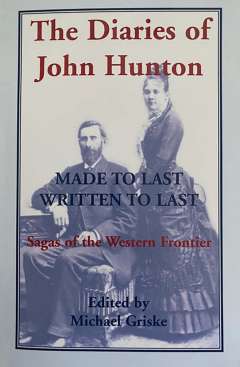The Many Times of John Hunton
By Tom Rea
Some books tell their stories in blunt chronology: First this happened, then this, this and this, and finally this. Others work differently, blending events from different periods that rhyme, resonate, advance or recircle in ways they would not do if told in order. Last fall at the approach of November, Native American Heritage Month, we heard from a writer wondering if we’d like a piece on the diarist John Hunton’s experiences of the Indian Wars. We answered that we already had several articles on major events of those times, but we had next to nothing about Hunton, and would like to learn more.
 In short order Michael Griske, grandson of Hunton’s good friend L.G. “Pat” Flannery, sent us a clear, brief account of Hunton’s life, which we published, gratefully. Griske’s account came from the opening pages of the book The Diaries of John Hunton: Made to Last, Written to Last. It is a book of many layers: Griske edited it in the early 2000s for publication in a single volume, from four books of Hunton diaries that Flannery had edited and published in the 1950s and ‘60s and two more published by Flannery’s wife, Alice, after he died in 1964.
In short order Michael Griske, grandson of Hunton’s good friend L.G. “Pat” Flannery, sent us a clear, brief account of Hunton’s life, which we published, gratefully. Griske’s account came from the opening pages of the book The Diaries of John Hunton: Made to Last, Written to Last. It is a book of many layers: Griske edited it in the early 2000s for publication in a single volume, from four books of Hunton diaries that Flannery had edited and published in the 1950s and ‘60s and two more published by Flannery’s wife, Alice, after he died in 1964.
Those books added context, comment and first-hand anecdote to the laconic notes Hunton himself had kept in the Fort Laramie area from the mid 1870s through 1900. For more than a dozen of those years, Hunton made daily entries. A Confederate veteran, he arrived at Fort Laramie in 1867, became a prosperous Army contractor and freighter, made and lost a fortune in cattle and went on to become a surveyor, county commissioner and a commissioner of the U.S. land office. His diary entries are packed with facts, people and events—but they need the treatment Flannery and, later, Griske gave to be accessible to a modern reader.
In 1921 Pat Flannery as a young man came from Denver with his family to ranch and found a newspaper in the area around the former fort. There, he met Hunton, then in his early 80s. Hunton had been the Army post’s last civilian trader and still lived on its grounds among the crumbling adobe buildings.
Flannery was a good listener. “On rare occasions,” he would write much later, “while jogging along some dusty road behind Mr. Hunton’s sturdy driving team, Dutch and Brownie, the old gentleman’s customary reserve would break down and he would start to talk, almost as if to himself, of the old days and, sometimes, of his travels with Lallee [his half-Lakota wife] across the plains and mountains he loved so well. At such times, I soon learned that my cue was to keep as quiet as possible. . . .”
Hunton became close to the family and struck up a special friendship with six-year-old Billie Flannery; she and the old man could often be seen walking around the fort grounds holding hands. One hot summer day, Flannery spotted his little girl creeping along the ground near a stock tank, making chopping motions with a toy hatchet as she approached a coiled rattler. It was ready to strike. Hunton saw the same thing at the same moment “and before we could make a move,” Flannery wrote later, “he stepped around the corner of the building, raised his Webley [revolver] with hand steady as a rock despite his more than 80 years, and cleanly shot off the snake’s head.” Billie grew up to be Griske’s mother.
When Hunton died in 1928, he bequeathed the diaries to Flannery. Flannery went on to a life of distinguished public service. He merged his weekly newspaper, the Fort Laramie Scout with the Goshen County Journal in Torrington, served in the Wyoming Legislature, chaired the Wyoming Democratic Party at the time of its greatest power in the state and administered New Deal programs in Wyoming. Then he left that high-level job to enlist, in his late forties, as a $21/month private in World War II. After the war Flannery served in Washington on the staff of Wyoming’s U.S. senator Joseph O’Mahoney until retiring back home in 1953. Now he had time for history. He began readying the Hunton diaries for publication.
As an epilogue, Griske includes Flannery’s account of a trip he and Wyoming State Engineer and trails historian L.C. Bishop and two other comrades made in January 1956 along “bull-train and stage coach routes of Wyoming’s historic era.” It was a route Hunton would have taken many times in his freighting years. On snow-drifted county roads and two-tracks they drove north from Cheyenne, past the site of Hunton’s 1870s road ranch at Bordeaux, Wyo., out into the middle of the Powder River Basin up the old Bozeman Trail route to Buffalo and Sheridan—a nostalgic three-day trek.
Hunton, finally, kept vivid daily accounts but he was a busy man and left a lot out; when Flannery began publishing the diaries in the 1950s, he filled in many gaps. But Flannery, too, left a lot out, about the nature of his friendship with Hunton and how the diaries came into print. Griske has filled in many of those gaps. It’s a book of many layers. Warning: They’re not all in chronological order, but then neither are our own memories of the people and times, now gone, we remember most clearly.
